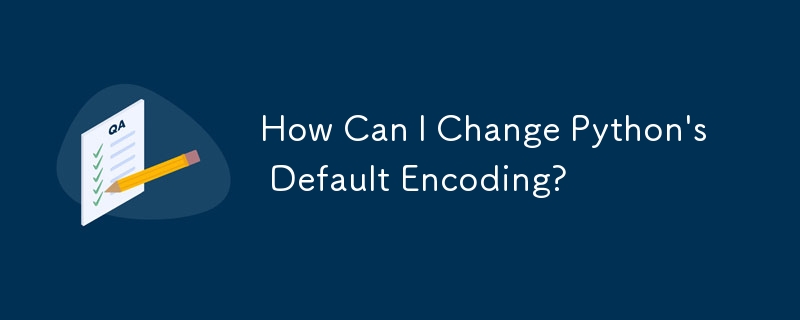How Can I Change Python's Default Encoding?
Dec 14, 2024 pm 02:22 PM
Python Encoding Quandary: Setting the Default
Despite experiencing recurring encoding issues when launching Python applications from the console, the IDE PyDev ensures seamless operation by leveraging UTF-8 as its default character encoding. This has prompted the question: how can the default encoding be modified in Python?
While previous suggestions to utilize the sys.setdefaultencoding function have been met with the obstacle of its removal during Python startup, an elegant solution has emerged. By reloading the sys module, the setdefaultencoding function is effectively restored, allowing for the modification of the default encoding.
Implementation:
import sys
# sys.setdefaultencoding() does not exist, here!
reload(sys) # Reload does the trick!
sys.setdefaultencoding('UTF8')Caution:
This approach should be employed with prudence. The default encoding is meticulously designed as ASCII to ensure compatibility with third-party code. Modifying this default without fully understanding its implications carries the risk of disrupting applications that assume ASCII as the standard.
Python 3.9 Compatibility:
It's worth noting that this technique may not function optimally in Python 3.9 due to significant changes in how the interpreter handles encoding.
The above is the detailed content of How Can I Change Python's Default Encoding?. For more information, please follow other related articles on the PHP Chinese website!

Hot Article

Hot tools Tags

Hot Article

Hot Article Tags

Notepad++7.3.1
Easy-to-use and free code editor

SublimeText3 Chinese version
Chinese version, very easy to use

Zend Studio 13.0.1
Powerful PHP integrated development environment

Dreamweaver CS6
Visual web development tools

SublimeText3 Mac version
God-level code editing software (SublimeText3)

Hot Topics
 How Do I Use Beautiful Soup to Parse HTML?
Mar 10, 2025 pm 06:54 PM
How Do I Use Beautiful Soup to Parse HTML?
Mar 10, 2025 pm 06:54 PM
How Do I Use Beautiful Soup to Parse HTML?
 How to Use Python to Find the Zipf Distribution of a Text File
Mar 05, 2025 am 09:58 AM
How to Use Python to Find the Zipf Distribution of a Text File
Mar 05, 2025 am 09:58 AM
How to Use Python to Find the Zipf Distribution of a Text File
 How to Work With PDF Documents Using Python
Mar 02, 2025 am 09:54 AM
How to Work With PDF Documents Using Python
Mar 02, 2025 am 09:54 AM
How to Work With PDF Documents Using Python
 How to Cache Using Redis in Django Applications
Mar 02, 2025 am 10:10 AM
How to Cache Using Redis in Django Applications
Mar 02, 2025 am 10:10 AM
How to Cache Using Redis in Django Applications
 How to Perform Deep Learning with TensorFlow or PyTorch?
Mar 10, 2025 pm 06:52 PM
How to Perform Deep Learning with TensorFlow or PyTorch?
Mar 10, 2025 pm 06:52 PM
How to Perform Deep Learning with TensorFlow or PyTorch?
 How to Implement Your Own Data Structure in Python
Mar 03, 2025 am 09:28 AM
How to Implement Your Own Data Structure in Python
Mar 03, 2025 am 09:28 AM
How to Implement Your Own Data Structure in Python
 Serialization and Deserialization of Python Objects: Part 1
Mar 08, 2025 am 09:39 AM
Serialization and Deserialization of Python Objects: Part 1
Mar 08, 2025 am 09:39 AM
Serialization and Deserialization of Python Objects: Part 1








